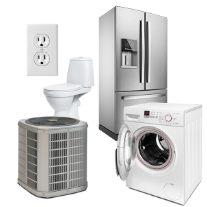Moving into a new house is one of the most exciting, expensive, and stressful things you’ll ever do. Today, we’ll show you some ways to prepare yourself for home ownership before you move all your bulky furniture in. These ideas can save you time, money, and hassle in the long run.
1. Notify governmental, financial and insurance entities
Notifying governmental, financial, and insurance entities about your move should be one of the first things you do (after notifying family and friends about the good news). Here’s a quick list of places you should notify as soon as possible:
- Post office: Do this first to assure that you don’t miss important mail as you move. You can fill out a Change of Address form online at USPS.com or visit your local post office to get a Change of Address form.
- Insurance companies: You’ll need to set up homeowner’s insurance anyway, but make sure all other insurance companies (e.g., health, auto) know about your move so that any potential claims don’t get caught up due to mixed addresses.
- Banks: Financial institutions are stringent about having up-to-date information.
- Telecommunications companies: Internet, phone, and cable companies will need to know about your new address to transfer services over promptly.
- Utilities companies: You’ll need to notify water, electric, trash, and gas companies of your move so they can turn on your utilities.
- DMV/RMV: You’ll likely need to do this in person. In some states, you can avoid paying for a new license or registration simply by notifying them.
Check each institution’s website. You may be able to change your information online or through a simple phone call.
2. Cancel or reschedule any deliveries
If you regularly receive any newspapers, catalogs, or other publications, be sure to reschedule these services to continue at your new address.
3. Change your locks
One of the first things you should do—before you move in completely—is change the locks or have them re-keyed. Even if the previous owners are great people, you don’t know who else has keys to your home. You want to make sure that you know exactly who has access to your new home.
4. Check your smoke alarms and carbon monoxide detectors
Smoke alarms save lives. Test your smoke alarms to make sure they work properly. If the house doesn’t have a carbon monoxide (CO) detector, plan on installing one before you move in. Carbon monoxide is odorless, colorless, and can be deadly or cause brain damage if not detected quickly. When you first calibrate your CO detector, do it outside. This helps ensure that the detector uses fresh air for its baseline reading.
5. Check for plumbing leaks
Check your home thoroughly for any plumbing leaks, running toilets, or dripping faucets. There’s an easy shortcut you can use for after you’ve turned your water service on. First, check your water meter and record the reading. Then, find a few hours when nothing will use water. Check the meter again. If the reading has changed at all, you may have a plumbing leak that you’ll want to fix as soon as possible.
This is also a great time to find the water main, gas shutoff valves, and breaker box. This way, you’ll know where they are if you ever need to shut them off in an emergency.
6. Replace old air filters
Replacing your air filters can help prolong the life of your HVAC system and make it more efficient. It also keeps the air you breathe clean. Dirty filters make HVAC systems work much harder to pump lower-quality air. Check the spatial measurements of your air filters before heading out to buy new ones.
7. Check the water heater
The ideal water heater temperature is 120°F. If the water is any hotter, it can scald you. Additionally, older water heaters may not have any insulation, which can cause them to run less efficiently (i.e., more expensively). You may want to wrap your water heater in an insulation blanket if that’s the case.
There are two ways to determine whether you should wrap your water heater.
- If the tank is warm to the touch
- If the R-value on the water heater’s sticker is less than 24
For your safety, be careful not to cover the top or bottom of the heater, the thermometer, or the burner compartment.
8. Service your heating and cooling appliances
Double-check that your heating and cooling appliances work properly as soon as possible. Don’t wait until you need it to learn that you don’t have it. It’s best to have all of the mechanical parts cleaned and serviced to make sure they work and operate at their optimal efficiency. If you have a systems and appliances home warranty with 2-10 Home Buyers Warranty (2-10 HBW), we can help you address breakdowns.
9. Hang window treatments
Window treatments let you control for privacy and temperature in your home, the latter of which can decrease your energy use and save you money. Hanging them is easier if you do it before the furniture gets in the way.
10. Deep clean the entire house
Some sellers will leave the house pristine when they move out. Others won’t. If your house isn’t pristine when you move in, you’ll want to thoroughly clean your bathrooms, refrigerator, oven, floors, cabinets, and walls. If you’d rather not do it yourself, hire professional cleaners and specify that you want a deep cleaning.
Adjusting to home ownership is a process. The last thing you want in that process is a major system or appliance breaking down. If your real estate agent, builder, or seller didn’t include a home warranty to protect you, 2-10 HBW can help you protect more and pay less.
2-10 HBW offers quality Home Warranty Service Agreement coverage for homeowners. Let us help you protect your home and budget.
Already a customer? You can renew your Home Warranty Service Agreement coverage today!
Do you have a 2-10 HBW structural warranty? You can purchase Home Warranty Service Agreement coverage today!
Related content
How to Find Your Home Water Main (Shutoff Valve)








